Studyplan user manual
Creating and managing a study plan
To create a studyplan, go to Site administration -> Courses -> Studyplans -> Manage Studyplans
You will now see a screen like the following
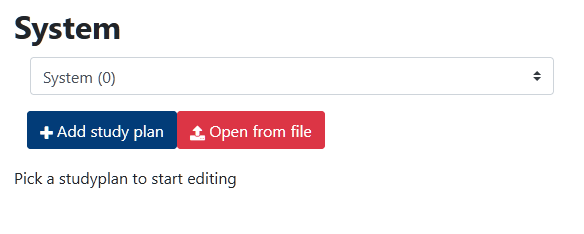
If you do not yet have an exported studyplan to import, pick Add study plan to create a new study plan
You are now asked to provide details for this new studyplan

The screen allows you to specify the full name, code or short name and description for this specific plan
You can also choose the category context in which to place this study plan. This is useful to manage access rights in a large moodle installation
The next options give more information about the timing of the plan. The number of slots to place courses in the plan can be specified. This is usually used to show the different periods in the academic year. You can expect this to become more explicit in upcoming versions of the plugin. The start date and end date of the plan help to show students and teachers which plans are current, and which were finished in the past. They will default to start on august 1 of this year and continue until august 1 of next year, since that matches most academic years.
Finally we have the aggregation style, which is ised to determine how the courses show grades. There are a number of options available:
- Moodle course completion This is the recommended method to use. All the conditions selected in the moodle course completion will be shown in the progress list.
- Manual: Completed + required goalsManually select a number of gradable activities from the course, which will be used to determine grade. Extra options for this method
- Manual: Progress/Completed/Excellent classic Deprecated! Do not use! This is an old and convoluted method that is only in here for compatibility reasons
Details for Manual: Completed + required goals
With this aggregation method you manually select which grade items are used in the progress report. The design intent is to prepare a number of gradable items, and describe the learning objectives for each course and use these to indicate completion. While any grade will be properly shown, it makes most sense to use a scale which indicates if the student has either met the objective or not. The teacher or studyplan editor can also mark certain gradables/objectives as required or compulsory.
The final outcome for the courses will then be determined based on the percentage of met objectives, provided that all required/compulsory objectives are met

The added options allow you to set the threshold percentage of completed objectives in each course to determine the outcome as excellent, good or completed. If an objective is not met it will be marked as either "progress" (meaning that the student's work needs to be improved) or "incomplete" (meaning that the student has not started working on this goal yet)
When failed results are enabled, any "progress" will be marked as "failed" when the course end date has passed
Finally, you can opt to have an object ive
Setting up studylines
Before you can add courses to the studyplan, you have to define study lines. You use them to group together courses in logical categories. Most likely these are categories or themes within your curriculum.
For performance reasons, study lines can only be edited when in study line edit mode. The courses and flow between them will be hidden, so the lines can be reshuffled and edited. You can toggle studyline edit mode with the toggle switch edit stydy lines
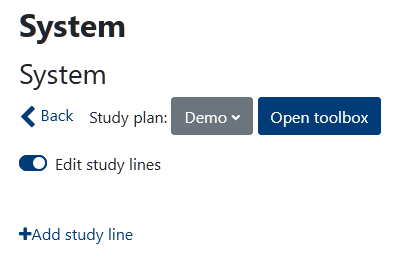
Using the Add study line link, you can add a new studyline. You will then get a new window where you can enter details and select a handle color for this line

Here you can enter a full name for the study line that will be shown when you hover over the name, and a code that is a short name which will be shown in front of the study line. Often this can be a short code. The color you pick will be shown in a little tab in front of the study line.
You can drag study lines to re-order them after you place them using the crosshair arrows
Using the and symbols you can edit and delete the studyline (only empty studylines can be deleted)

If you have many studyplans using the same study line make-up you can export the first studyplan after you set up the study lines, and then import it on the next study plans.
(Use Advanced -> Backup studyplan to find the backup and restore features)
Adding courses
To add courses, you need to exit study line edit mode and open the toolbox using the button. The toolbox will now open on the right of the screen. (Using the toggle button on top, you can also switch it to the left of the screen if needed)

The toolbox shows you all the categories you have access to and the courses in them. Simply drag the course you want to include from the toolbox and drop it in one of the slots in the studyplan that now appear.
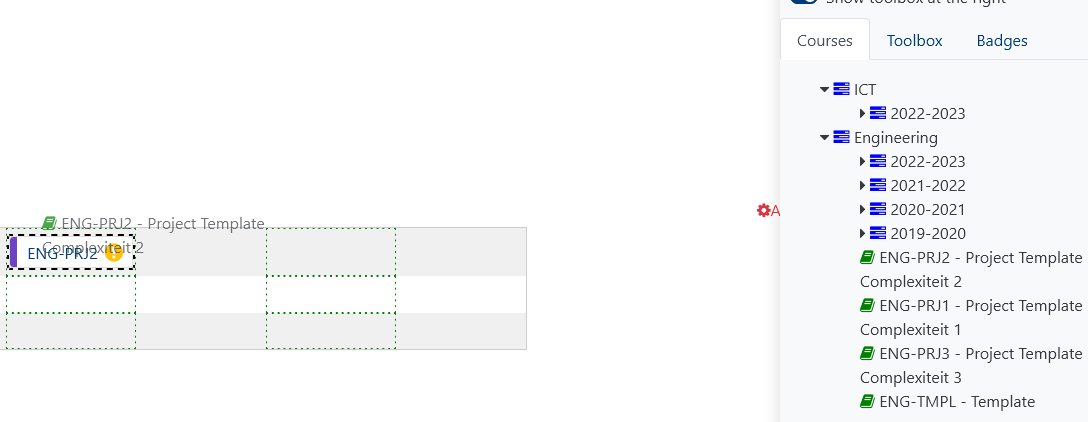
To re-arrange the courses in the study plan, simply drag and drop them from the places they are now in.

To remove a course from the study plan, simply drag it to the red garbage bin that appears on dragging
Layers within a study line
To add a course to a new layer within a studyline, drag it to the bottom of the study line. There are small slots shown there, which will fully open when the course is dragged over them
Configuring periods
All periods in the study plan will have a label showing the timing and it's short name directly above their course columns in the timeline. Upon hovering over the short name, it's full name will appear.Also, the period matching the current date, will be highlighted in the color indicated by the
--highlightcss variable, which corresponds to the value of the
--infocolor by default.


At the start, the periods start and end times will be naively selected by splitting the study plan's duration among the number of periods.
By clicking on the icon, you can open the edit screen and change the period's full name,
short name, start time and end time
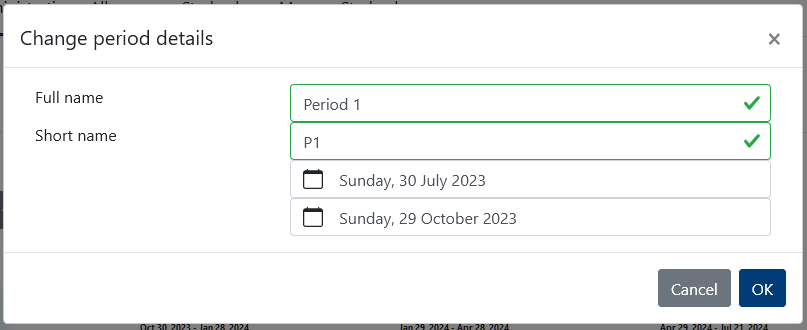
Before you start dragging courses into a studyplan page, make sure you have the periods configured correctly.
Configuring courses
Once a course is added to the studyplan, an icon shows if it needs to be configured () or is already configured ().
By clicking on the course title (it's shortname, or a configured custom field), you can view the details, and configure it where applicable. The configuration is dependent on the aggregation method for the study plan:
Moodle course completion
When using moodle course completion as a base, all configuration is done in the course's completion settings. The course details show a gear icon in the title, which takes you directly to the course completion configuration. Once it is configured, the course details will show you exactly how the course completion is configured
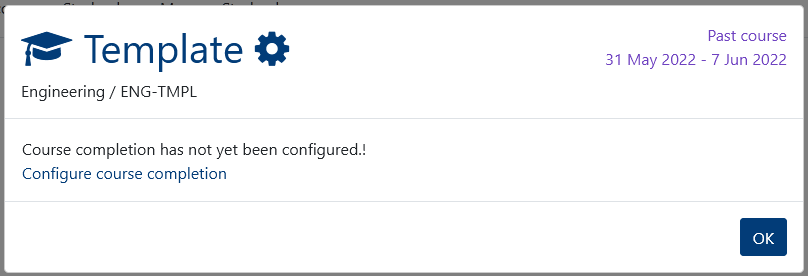
Manual: Completed + required goals
In this mode, the course details show you all the gradable activities in the course. You need to select which of them will be used to determine progress and will be shown to the students and teachers in the studyplan view. You can also mark gradables ad required. Gradable activities marked as such will all need to be completed for the course to be marked as completed, regardless of the minimum percentage configured
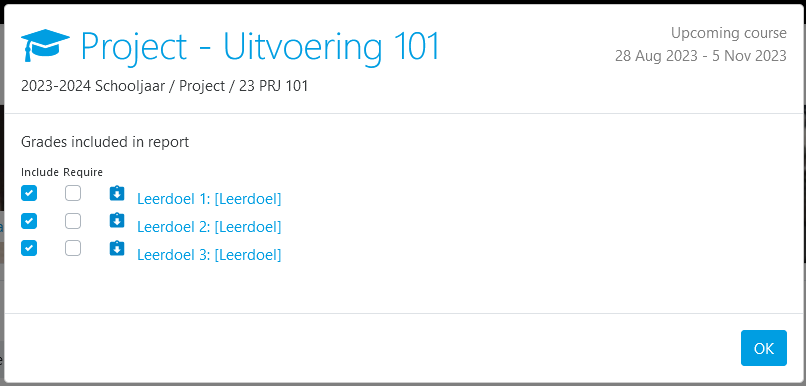
Course start and end times
Often, the course will have their start and end times configured differently than the period you drop them in. If this is the case, a screen will appear asking if you want to update the course's start and end times. The time details of both course and period will be shown for your comparison. By clicking , the course's start and end times will be updated to those of the period. Any activity dates set will be adjusted according to the changed start date.
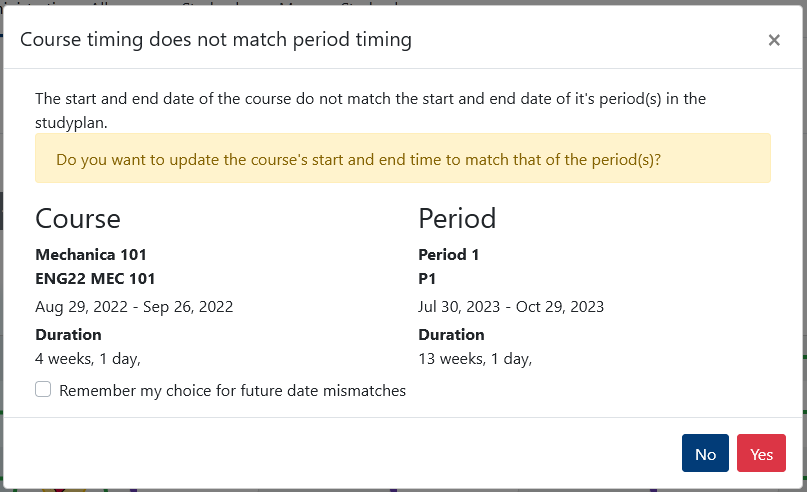
If you do not change the course start and end times at this moment, you always have the opportunity later on by clicking the icon in the course detail screen. (As seen in the screenshot below).
This icon will be (color --success) to indicate if the course timing matches period timing. If not, it is shown as (color --warning)
Courses spanning multiple periods
If a course should span multiple periods, you can specify this in the course detail screen.
On the top right of the course details screen you can select the desired period span of this course.
Do note however, that the available spans are limited by the available space to the right of the course in the studyplan

Upon selecting the span you want, the course display will immediately be updated to reflect the changes.
immediately after this, you will see the screen asking if you want to change the course start and end times to reflect the
new period span.
Adding badges
The toolbox also shows you the site-wide badges that are available for students. These can be dragged into the slots around and between the courses.
When you click on the icon in the badge it shows you additional information about the badge

Drawing the flow
You can draw arrows between the courses and add flow indicators to show students how different courses are related in the studyplan
While there are many possible relations between courses, it is best to limit the arrows to the most obvious relations. The studyplan can easily become too crowded to give a good overview. Use junctions to combine multiple arrows into one if you do need to show the relation from many courses to a few.
Drawing arrows
You can draw arrows by dragging them from one course or flow indicator to another. Look for the green square on the right of the item. Then click and hold to drag the arrow. Once you do, a red square will appear on all the items that the arrow can end on. Drop the end of the arrow on one of those red squares to complete the arrow.
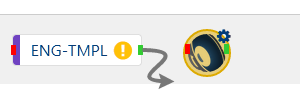
Removing arrows
To remove an arrow, click on the green square where the arrow starts. A red trash can icon will appear for each line that starts there. Hover over the trash can icons to find the line you want to remove. The arrow for each trash can icon will be highlighted in red once you hover over it with your cursor. Once you find the arrow you want to remove, click the trash icon.
To close the trash icon menu without removing an arrow, click the green square (now red) again.
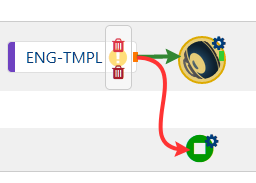
Adding flow indicators
You can add the following flow indicators:
- Junction Used to combine the results of multiple arrows. The color and resulting arrow will be based on the combination of the incoming arrows
- Finish Used to indicate the end of a study line. It's color is based on the combination of the incoming arrows, just like the junction
- Start/continue These indicators are always green and can be used to indicate the start of a series of courses
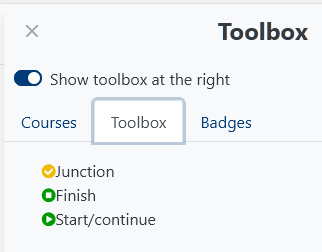
By clicking on the icon in the junction and finish indicators, you can select how the incoming arrows will be combined. The indicated numer of arrows need to be completed in order to show the indicator as completed
- All entries
- 2/3 of entries
- Half of entries
- All entries
Using the Manual aggregation method, these conditions are also used to determine whether a junction or finish will be shown as good or excellent In those cases, at least the specified number of arrows need to be good or excellent in order to color the indicator as such.
Associating students with a studyplan
You can associate users with the studyplan in two ways: Individually or by cohort
The recommended way is association by cohort, since that allows to dynamically allocate users to courses and studyplans by allocatong them to cohorts. Assigning students to a studyplan individually is only useful in some fringe cases.
To edit associations, click on the associations link in the studyplan, or click on the icon in the studyplan overview.
You will now get the association window
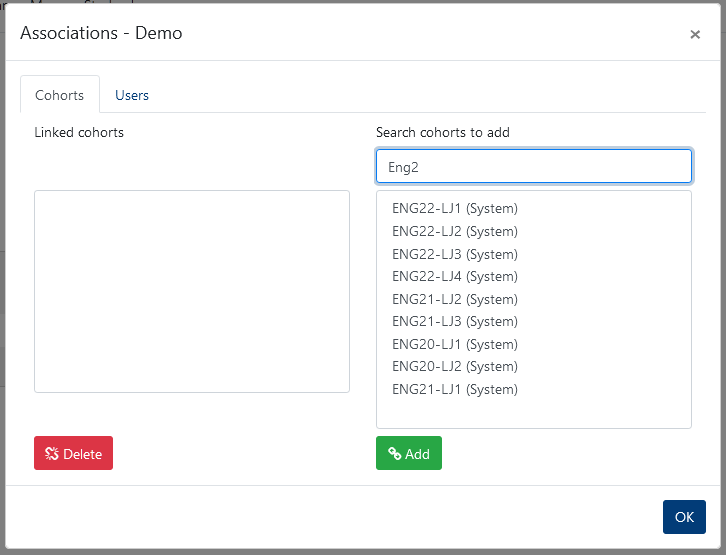
In this window, type the first few letters of the cohorti> you want to link into the search bar. The matching cohorts will now be shown.
Click to add the cohort to the studyplan
To remove a cohort from the studyplan, select it from the left list, and click
In order to link individual students, click students and follow the same procedure as lined out above for cohorts.
If you have cascading cohort sync enabled (see configuration), the system will automatically create a cohort-sync enrolment to all courses in the studyplan for each cohort you have linked here. It can also automatically remove those enrolments when a cohort is unlinked from a studyplan.
Individually linked students can also be cascaded down to the courses (if the feature is enabled). In those cases a manual enrolment is created for the users in each of the studyplan's courses. Those enrolments will never be automatically removed, since that might deprive a student of study content.